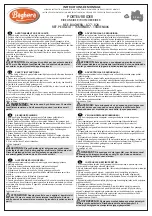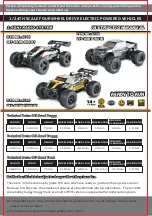
57
12. Cleaning and Maintenance
a) General Information
Before cleaning or servicing, turn the speed controller off and completely disconnect the drive battery from the speed
controller. If you have driven the vehicle before, let all parts (e.g. motor, speed controller, etc.) cool down completely
first.
Clean the whole vehicle of dust and dirt after driving, e.g. with a long-haired clean brush and a vacuum cleaner.
Compressed air aerosols can also be helpful.
Do not use cleaning aerosols or conventional household cleaners. This may damage the electronics and lead to
discolouration of the plastic parts or the body.
Never wash the vehicle with water, e.g. using a high-pressure cleaner. This will destroy the engine, speed controller
and receiver. The vehicle must not become damp or wet!
A soft cloth, slightly dampened, can be used to wipe the car body. Do not rub too firmly in order to avoid scratch
marks.
b) Before or after Every Drive
Motor vibrations and shocks during driving can loosen parts and screw fittings.
Therefore, check the following items before and after every drive:
• The tight fit of wheel nuts and of all vehicle screw fittings
• Fastening of speed controller, on/off switch, receiver
• Glue-connections of tyres and runs or tyre condition
• Attachment of all cables (they must not get into movable parts of the vehicle)
Also check the vehicle for damage before or after every use. If you find any damage, the car may not be
used anymore and has to be taken out of operation.
Only original spare parts must be used to replace worn vehicle parts (e.g. tyres) or defective vehicle parts
(e.g. a broken transverse link).
c) Wheel Change
The tyres are glued to the wheel rim to prevent them from coming loose. When the tyre is worn down, the entire wheel
has to be replaced therefore.
The wheels are available pre-assembled, i.e. tyres glued to wheel rims, as spare parts.
If you want to purchase the wheel rims and tyres separately, you still have to glue the tyres to the wheel rims.
A tyre not or improperly glued on may loosen while driving (e.g. in fast curves) or the tyre may turn on the
wheel rim when accelerating.
After loosening of the wheel nut, the wheel may be removed from the wheel axle.
Then the new wheel is plugged on so that the hexagon socket on the wheel rim‘s inside is precisely pushed onto the
wheel tappet nut.
Содержание 49 01 27
Страница 122: ...122 ...
Страница 123: ...123 ...
















































